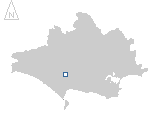
Search:
Dorchester
The county town, aptly located near the heart of the county. It is believed that the town was originally founded in 80AD as the only Roman town in Dorset, possibly on or near the site of a garrison fort, no trace of the fort has been found to date. People were however already living in this area from well before that date, evidence of these former inhabitants can be found all around – from the late Neolithic henge of Maumbury Rings (c. 2500BC) just south of the town centre, to the massive Iron Age hillfort Maiden Castle.
The town limits were, until around the start of the 19th century, demarked by the line of the former Roman town walls. The compact street pattern within this enclosure largely still remains, as a grid like pattern of small intersecting streets and alleyways. The historical importance of the town as administrative centre of the county is evidenced throughout. The views of the town shown here were taken on a typically autumnal day in late September.

|

|

|

|

|

|

|

|

|

|

|

|

|

|

|
|
To view any image full size - simply click on the thumbnail
| ||||
Find out more ... |
|
In the top row of pictures:
In the middle row of pictures:
In the bottom row of pictures:
Nearby locations that also feature in galleries on this site:
More views of Dorset in September Other sites on the webThe Dorset Page: Dorchester – local information and links to further resources on the web Maps of the area on streetmap.co.uk: 1:50,000 – detail, 1:250,000 – locality and route to get there
|